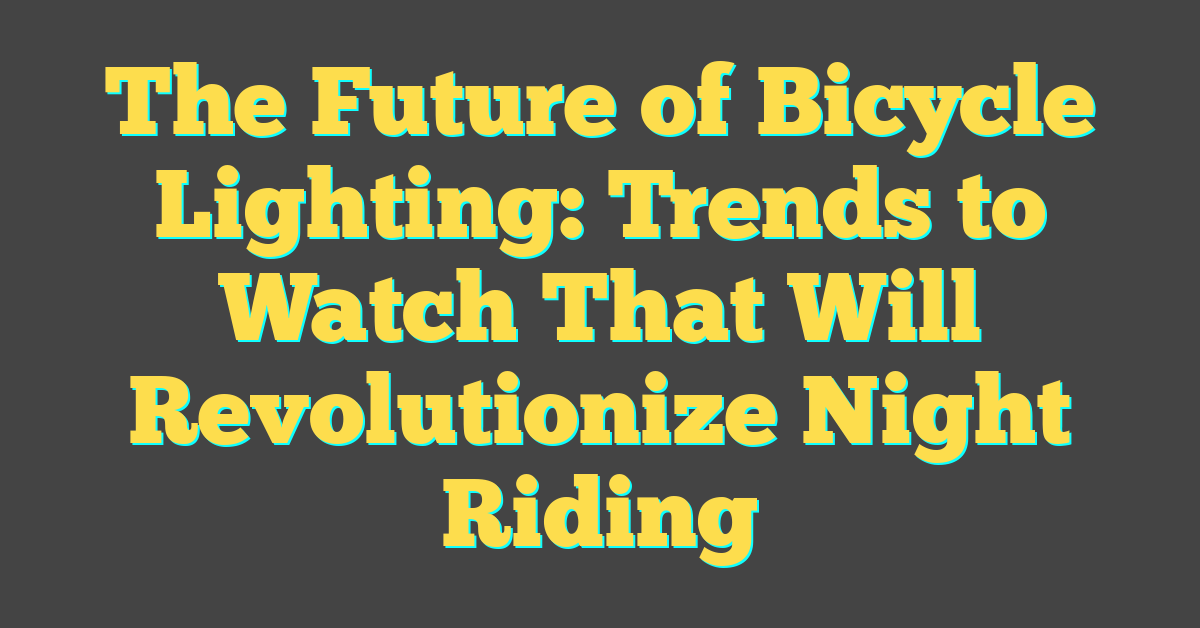Cycling through Europe feels like stepping into a whole new world of biking culture. From bustling city streets to serene countryside paths, it’s clear that cycling isn’t just a mode of transport here—it’s a way of life. But as I quickly discovered, there’s more to it than hopping on a bike and pedaling away.

One thing that stood out to me was how seriously Europeans take bike lighting. It’s not just about staying visible; it’s a legal requirement in many countries. Whether you’re cruising through Amsterdam at dusk or navigating Berlin’s busy roads after dark, proper lighting isn’t optional—it’s essential.
But beyond the rules, there’s a unique charm to how cycling is woven into daily life. It’s fascinating to see how cultural attitudes toward biking vary from country to country, making every ride an opportunity to experience something new.
Overview Of Cycling In Europe
Cycling in Europe blends practicality and passion, making it a staple in daily life for millions. From compact city streets to sprawling countryside trails, bikes serve as primary transportation and a source of leisure. Each country showcases its own relationship with cycling, shaped by history, urban planning, and culture.
Cities like Amsterdam and Copenhagen lead the scene. Dedicated bike lanes, bike-friendly traffic systems, and a high percentage of commuting cyclists define these urban hubs. In contrast, places like the French Alps or Tuscany offer thrilling rides for adventure seekers, with picturesque landscapes that make every pedal memorable.
Legal regulations play a key role in European cycling culture. Many nations not only reinforce safety through bike lighting requirements but also encourage their use through well-lit cycling paths. For example, Germany mandates working front and rear lights, while countries like Denmark prioritize lighting even during daylight hours in dim conditions. These rules make nighttime cycling safer and emphasize visibility for all road users.
Cycling infrastructure supports this lighting culture. I’ve noticed that cities invest heavily in bike parking, well-designed lanes, and proper signage. It’s easy to see how these investments create a harmonious environment for cyclists, pedestrians, and drivers alike. This focus on infrastructure has significantly boosted the popularity of biking, making it accessible to people of all ages and skill levels.
Beyond laws and layouts, cycling in Europe thrives because of its communal spirit. Group rides, cycling clubs, and vibrant events like the Giro d’Italia or the Tour de France inspire people to ride more. Even casual cyclists feel connected to this larger movement. It’s not just about getting from one place to another—it’s about being part of something bigger.
Lighting Requirements For Cyclists
Lighting plays a crucial role in cycling across Europe, ensuring safety and legal compliance. As someone who’s passionate about bikes and lighting, I find it fascinating how laws and preferences vary by country.
Legal Obligations Across European Countries
Every country has its rules regarding bicycle lighting. In Germany, laws mandate front white lights and rear red lights, both of which must remain on while riding after dark or in low visibility. Denmark takes a similar approach, requiring cyclists to use steady or flashing lights visible from specific distances, typically 300 feet. In the Netherlands, front and rear lights need to be securely attached to the bike itself, unlike some countries that allow helmet-mounted options.
For travelers, understanding location-specific regulations is essential. Belgium, for example, demands pedal reflectors unless the bike is designed otherwise. France not only asks for lights but also requires reflective clothing outside urban areas at night.
Common Types Of Bicycle Lights
Cyclists generally choose between battery-powered or dynamo-driven lights. Dynamo lights, which I’ve installed on a few of my bikes, generate power as you pedal. They’re common in countries like Germany due to stricter legal standards and offer an eco-friendly, low-maintenance option. Battery-powered lights, available in USB-rechargeable versions, provide higher brightness, making them suitable for off-road or poorly lit paths.
Front lights often come in halogen, LED, or the more durable solar-powered designs. Rear lights typically use red LEDs, which I’ve found last longer and maintain visibility without draining power. Many modern models include flash modes for added attention, which satisfies legal requirements in several regions.
Importance Of Proper Lighting For Road Safety
Proper bike lights reduce accidents by improving visibility for cyclists and other road users. In urban areas, lights help distinguish bikes in heavy traffic. On rural roads, they signal presence to drivers, especially on curves or hills where beam projection matters most. I’ve noticed reflective accessories paired with lights amplify visibility, creating a safer biking experience.
Beyond safety, well-maintained lights set a good example for other riders. Demonstrating their importance encourages newcomers to invest in reliable gear, strengthening the cycling community.
Cycling Culture Across Europe
« International Cycling Laws: What Every Touring Cyclist Should Know Before Their Next Adventure
Traveling with Your Bike: Lighting Solutions for Different Destinations You Need to Know »
Cycling in Europe thrives on diversity, with urban centers and rural regions offering distinct experiences. Bike-friendly infrastructure, cultural practices, and the importance of lighting all shape the unique cycling environment in various European settings.
Differences In Urban And Rural Areas
Urban areas prioritize commuting and safety through extensive cycling infrastructure. Cities like Amsterdam and Copenhagen have well-marked bike lanes, traffic signals for bikes, and robust lighting regulations ensuring visibility at all times. For example, I’ve seen how Germany enforces bright front white lights and rear red lights, making night rides safer even in busy streets.
Rural cycling centers more on leisure and exploration, where lighting takes on a different role. While urban riders aim for functionality, rural cyclists—especially in scenic regions like the French Alps—often prefer high-powered lights designed for varied terrain or long rides. I always recommend lights that can handle sudden changes in terrain while maintaining long battery life. These varied needs across settings showcase how a cyclist’s environment influences their lighting choices.
Popular Cyclist-Friendly Destinations
Europe is home to destinations catering specifically to cyclists. Cities like Strasbourg and Utrecht lead in urban cycling with their exceptional traffic systems and accessible bike parking. It’s inspiring to ride through places with such a focus on making cycling seamless and enjoyable.
For adventurous rides, locations like Tuscany’s rolling hills and Norway’s fjords combine stunning scenery with challenging routes. I’ve found that bringing high-visibility flashing lights and backup batteries to places like these makes a big difference when facing sudden weather changes or shaded paths. Major cycling events such as the Tour de France also highlight these regions, fostering a cycling culture where community and preparation, including proper lighting, go hand in hand.
Challenges And Innovations In Bicycle Lighting
Effective bike lighting is crucial for safety and visibility, but cyclists face unique challenges that technology is striving to address. As someone passionate about cycling and lighting, I’ve seen how the industry continues to adapt.
Current Challenges Faced By Cyclists
Visibility remains a major concern for cyclists, especially in urban areas with heavy traffic and competing light sources. Bright city lights can make a bike’s lights harder to notice, reducing visibility in critical moments. In rural regions, limited street lighting increases reliance on personal lighting systems, yet long rides drain battery-powered lights, leaving cyclists at risk.
Weather conditions like rain and fog add another layer of difficulty, affecting how well even powerful lights perform. I’ve often noticed how water can dim LED efficiency or obscure the lens. Additionally, theft of high-quality lights continues to be a concern; quick-release mounts make them convenient but easy targets. Balancing effectiveness, durability, and security is an ongoing challenge.
Technological Advances In Bicycle Lighting
Innovative lighting designs are addressing these issues with impressive results. High-lumen LEDs with focused beams enhance visibility in mixed lighting conditions, ensuring cyclists stand out regardless of settings. Rechargeable batteries with extended lifespans or portable power banks make it easier to tackle long rides without worrying about losing light mid-trip.
Dynamo hub lighting is re-emerging as a practical solution for frequent riders, powering lights through wheel motion. Modern designs are lightweight and efficient, unlike older dynamos that created noticeable drag when pedaling. Adaptive technology, like ambient light sensors, now adjusts brightness automatically based on surroundings, which is a feature I’ve found to be an excellent upgrade.
Smart lights integrated with apps offer features like theft tracking and light pattern adjustments for better safety communication. Designs using durable, weatherproof materials ensure performance during rain or snow. These advancements make bike lights more reliable, effective, and user-friendly.
Tips For Safe And Enjoyable Cycling In Europe
Use Proper Lighting At All Times
I always carry reliable bike lights, no matter the time of day. In many European countries, proper lighting is mandatory after sunset or in low-visibility conditions. Germany, for example, requires white front lights and red rear lights, while Denmark outlines specific visibility distances. Lights like rechargeable LEDs or dynamo-powered ones are excellent for long rides and keep you visible in urban traffic or dimly lit countryside roads.
Check Local Cycling Rules
Each country has unique regulations for cyclists. Before any trip, I review local laws to ensure compliance. For example, in France, visibility vests are required outside cities at night, while in the Netherlands, improper positioning of bike lights can result in fines. Staying informed saves from unexpected penalties and ensures a safer ride.
Invest In High Visibility Gear
Besides lights, reflective clothing and accessories add an extra layer of safety. I prefer wearing a reflective vest or adding reflective strips to my bike frame. On busy streets or during group rides, such gear makes spotting cyclists easier for drivers and other road users.
Plan Routes Suitable For Your Skill Level
Cycling in Europe ranges from flat urban lanes to challenging hilly trails. Before starting, I review the route’s difficulty. For urban rides, cities like Amsterdam and Copenhagen have bike-friendly infrastructure, while Tuscany and the Alps offer more scenic but demanding options for seasoned riders.
Have A Maintenance Routine For Your Bike
A well-maintained bike guarantees a problem-free journey. I regularly check tires, brakes, and, most importantly, lighting systems. Carrying spare bulbs or batteries ensures you’re never caught unprepared if a light fails, especially on longer routes. This practice has saved me several times.
Adapt To Weather Conditions
European weather can vary drastically. During rain or fog, standard bike lights might not suffice. I recommend high-lumen lights that slice through poor visibility. Waterproof options paired with anti-fog sprays for lenses give an extra edge in bad conditions. It’s a small adjustment that makes a big difference.
Join Local Cycling Clubs
I’ve found riding with local groups a great way to learn about the region’s best cycling paths and rules. Many clubs share tips on lighting and gear, and group rides often encourage safer behavior, such as using proper reflective wear and lights. This adds a social dimension to cycling that’s hard to beat.
Utilize Cycling Apps
Modern apps help plan routes, track performance, and even manage bike lighting. Some of my lights sync with apps to adjust brightness levels automatically based on surroundings. They also double as alarms if someone tries tampering with the bike. Using such tools optimizes both safety and convenience.
Conclusion
Cycling in Europe is a beautiful blend of culture, practicality, and innovation. Every ride feels like a journey through history, scenery, and community, whether you’re navigating bustling city streets or exploring peaceful countryside trails. The importance of safety, especially with proper bike lighting, stands out as a shared value across the continent.
What I love most about cycling in Europe is how it brings people together. From casual riders to seasoned adventurers, there’s a sense of unity and respect that makes every ride special. Whether you’re drawn to the vibrant cycling infrastructure or the breathtaking landscapes, there’s no shortage of inspiration to hop on a bike and explore.




